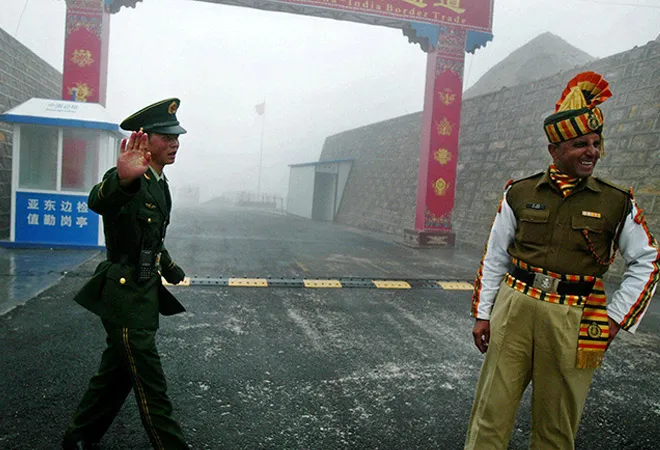
This on-going crisis on the Sino-Indian border has demonstrated the difficulty of challenging China’s fait accompli or “salami slicing” strategy in the high Himalayas. India’s “deterrence by denial” strategy was successful in stopping China’s road and infrastructure building in Bhutanese territory during the 73-day long military stand-off in Doklam in 2017. But, this was only possible because India’s troop mobilisation caught China off-guard as it sought to threaten India’s control of the Siliguri corridor, which connects India’s North-Eastern states to the rest of the country. In Beijing however, the lessons of Doklam seem to have caused a shift towards more aggressive coercive bargaining tactics, in turn rendering India’s “deterrence by denial” strategy along the 3,488 km long LAC inadequate. Patrolling and intelligence gathering (even with satellite imagery) in high-altitude mountainous terrains with hostile weather conditions is exceedingly challenging. Due to such conditions, India’s military outposts lie anywhere between 10-80 kms from the LAC, and cannot effectively “deny” opportunities for China to revise the status-quo at all points. India has sought to bridge the infrastructure gap vis-à-vis China, and built close to 61 roads along the LAC totalling 3,346 km—but these are still not sufficient. Particularly after 2005, the offense-defence balance on the Sino-Indian border shifted, as China improved its infrastructure in the Tibetan Autonomous Region by building roads, airstrips, and heliports, whilst also undertaking massive military modernisation programs. Thus, if India is to restrain Xi’s revanchist China, it must re-orient its deterrence policy towards “punishment.”
A deterrence by punishment posture would maintain India’s ability to inflict severe costs, which far exceed the benefits of offensive action by China. As Anit Mukherjee and Yogesh Joshi have argued, by “expanding and escalating the conflict into new areas and avenues” (egs. open up additional fronts on land, air, and the maritime), a punishment strategy would signal to China “that it cannot remain confident in its ability to control events”. India has already been preparing the grounds for such a strategy. Since the mid 2000s, for instance, it has added to its Mountain Strike Corps (MSC) for rapid counter-offensive operations in Tibet (“Him Vijay” exercises are already being held by them in Arunachal Pradesh—the Western sector of the LAC), improved its roads and logistical infrastructure, augmented its firepower with the acquisition of the 145 M-777 ultra-light Howitzers from the US in 2016, deployed the Brahmos cruise missile system and Smerch and Pinaka multi-barrel rocket launchers (MBRL) along the border, and has raised 6 new armoured regiments, equipped with 348 tanks and 3 mechanised infantry battalions. As Mukherjee and Joshi highlight, even the Indian Air Force (IAF), through its deployment of Su-30 MKI aircrafts instead of the Mig-21 interceptors, now carries the ability for “deep penetration”. The IAF’s capacity for counter-offensive action and rapid deployment of ground forces will be further bolstered with the acquisition of Apache attack helicopters, Rafale fighter aircraft, and more Chinook heavy-lift helicopters.
The IAF’s capacity for counter-offensive action and rapid deployment of ground forces will be further bolstered with the acquisition of Apache attack helicopters, Rafale fighter aircraft, and more Chinook heavy-lift helicopters
Henceforth, if China pursues territorial fait accompli strategies, India—even at the risk of casualties—must be prepared for limited military action on the LAC, which includes targeting critical Chinese infrastructure in border areas. In such areas, retaliatory strikes by infantry or special-forces, on either occupied areas or other pressure points along the LAC where India enjoys the tactical advantage, with artillery and armour support in the rear as a deterrent against escalation, could be used. Further, India can also exploit China’s frailties in the Indian Ocean Region and seek to interdict vital Sea Lines of Communication (SLOC), particularly those passing through the strait of Malacca. To bolster its counter-offensive capacity, the Indian Navy has already taken on lease a nuclear-powered attack submarine (SSN) from Russia—the INS Chakra and recruited the aircraft carrier INS Vikramaditya in 2012. Moreover, orders have been placed for an indigenous aircraft carrier, 7 stealth frigates, 6 diesel submarines, 30 other warships, 12 Boeing P8i maritime patrol aircraft, 45 Mig 29K aircraft, and over 200 helicopters”. In recent editions of its Malabar series of Naval exercises conducted jointly with US, Japan, and Australia, the Indian Navy has specifically sought to improve its Anti-Submarine Warfare capability to counter Chinese submarines. It must be noted however, that a strategy of punishment may still be more practicable on the land frontier as the China-Pakistan Economic Corridor allows China to reduce its reliance on Indian Ocean SLOCs, and India’s naval ships are vulnerable to low-cost asymmetric options such as carrier-killing missiles.
Even with respect to India’s capability to inflict punishment on China across the land frontier, considering China’s numerical superiority, questions still remain. In particular, India must take a more vocal stand on freedom of navigation in the South China Sea to ensure that China’s military resources are over-extended, and cannot be concentrated in its Western theatre. India’s commitment to the Quad and a deepening of its strategic partnership with the US, should either be leveraged to exact concessions on the border, or used to rapidly upgrade domestic military capacity. As this crisis as shown, there has been a deafening silence from India’s allies—such as the US, Russia, Japan or Australia. In fact, the deficiencies of the Quad in containing China have been apparent for a while. Therefore, if India commits to any collective military partnerships, it should offer to shoulder the operational burden in the Indian Ocean Region or perhaps partly even in the South China Sea, as long as its allies—who are wary of overextension (US) or unwilling to risk full-spectrum rivalry with China (Japan, ASEAN and Australia)—provide military aid and technological capacity-building. In other words, India should expressly use external balancing for internal balancing to overcome its historical mistrust of military alliances, while ensuring it can countenance a defence budget to match China’s military strength.
India must take a more vocal stand on freedom of navigation in the South China Sea to ensure that China’s military resources are over-extended, and cannot be concentrated in its Western theatre
One of the advantages of using “deterrence by punishment” in disputed areas caught between the “differing perceptions of the LAC” is that they do not contain any vital natural resources or ethnic-kin populations. This means that the potential payoffs of offensive military operations is still low. But, it is also important to recognise that such a deterrence posture can risk rapid and uncontrolled escalation. To protect against this, India must clearly identify a deterrence threshold, forms of Chinese aggression that it would choose to punish, and the strategic points which could be targeted though limited offensive strikes. For instance, incursions by patrol units of the PLA of a temporary nature cannot be held comparable to territorial expropriation or land grabs worthy of retaliation. Additionally, in situations where India can pre-empt Chinese ingress, a deterrence by denial strategy is still useful. India must also limit its counter-actions across the land frontier to the forward edge of border areas, in order to avoid further escalation, and the operational challenges of targeting deeper-lying and heavily defended areas on the Chinese side. Finally, significant investment in the modernisation of India’s armed forces would still be required for China to respect India’s capacity to exact costs.
The events of June 15 should set alarm bells ringing in New Delhi. India’s approach, since the 1962 War, of hedging and buck-passing can be ill afforded against Xi Jinping’s China and its “wolf-warrior diplomacy”. India must “punish” rather than “deny” Chinese adventurism—a significant revision of the rules of engagement. Progress made by Deng Xiaoping and Rajiv Gandhi in the 1980s has unfortunately come undone. The pathway to a diplomatic resolution of the Sino-Indian border will run through India’s ability to first ensure conventional deterrence.
The views expressed above belong to the author(s). ORF research and analyses now available on Telegram! Click here to access our curated content — blogs, longforms and interviews.




 PREV
PREV


